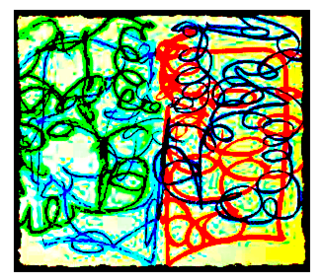Trauma
Working Bilaterally via Expressive Arts to Resolve Trauma
Is using two sides better than one?
Posted January 31, 2021

Bilateral Stimulation (BLS) is a widely used approach in many current strategies to address trauma. It is found in practices like Eye Movement Desensitization and Reprocessing (EMDR) and various forms of tapping and sensory integration methods. Sensorimotor applications of expressive arts therapy complement BLS and incorporate developmental, brain-wise, and body-based concepts from contemporary and innovative trauma treatments. In contrast to protocols like Sensorimotor Psychotherapy® (SP) that focuses on talking about body awareness, expressive arts approaches value implicit communication—the nonverbal expressions that communicate the body's experience of threat as well as safety.
As I have noted in previous posts, bilateral work simply means “involving two sides.” Sensory integration is often associated with bilateral techniques that assist individuals in organizing specific sensations via methods commonly found in occupational therapy. In the process of reparation from psychological trauma, various forms of bilateral stimulation or movement seem to be effective in engaging cross-hemisphere activity in the brain, such as Francine Shapiro’s discovery of an eye movement protocol that eventually came to be known as EMDR (Eye Movement Desensitization and Reprocessing (Shapiro, 2001). In expressive arts therapy, bilateral movement, drawing, self-tapping, or listening to sounds can be part of sensory-based psychotherapeutic experiences (Malchiodi, 2011/2020). These types of applications seem to have an impact on recovery from traumatic events because for many individuals, the limbic system and right hemisphere of the brain are hyperactivated by actual experiences or memories of trauma. While not completely understood, specific processes found in bilateral stimulation may help regulate body and mind thus allowing explicit memory to be reconnected with implicit memory.
Bilateral drawing is a deceptively simple art-based activity that has been around since at least the 1950s that capitalizes on self-regulating properties similar to rocking, walking, cycling, or drumming. Some practitioners refer to bilateral drawing as “scribbling with both hands” because the intent is not necessarily to make a specific image, but to instead just engage both hands in spontaneous drawing with chalks, pastels, or other easily manipulated art materials. Like many art and expressive arts therapists, I have used this activity for several decades and actually learned it during college art courses as a way of “loosening up” before beginning to draw or paint (see film below).
Florence Cane (1951) is one of many early practitioners who observed a connection between free-form gestural drawing on paper, the kinesthetic sense involved in movement, and the embodied qualities of the experience. In her work with children and adults in the mid-20th century, Cane hypothesized that it is important to engage individuals through movements that go beyond the use of the hands to engage the whole body in natural rhythms. In particular, she refers to large swinging gestures that come from the shoulder, elbow, or wrist to not only liberate creative expression, but also act in a restorative capacity to support healthy rhythms in the body and mind. In other words, these rhythmic movements can be practiced in the air and then later transferring them to paper with drawing materials.
Therapists echo Cane’s observations in clinical applications of expressive art with individuals, using several variations of the simple scribble in cases of trauma and bilateral drawing methods (McNamee, 2003) for not only self-regulation, but also in trauma processing (Malchiodi, 2020; Urhausen, 2015). In the case of bilateral drawing, there is an assumption that because both hands are engaged that both hemispheres of the brain are stimulated. When combined with trauma narratives, it is believed that visual, auditory, or tactile cues help the individual by directing focus on the present rather than what has happened in the past.
Applications of bilateral expressive arts seem to be effective, but most of these arts-based applications have not been thoroughly explained and only demonstrate preliminary effectiveness through small scale observational studies and case examples. Ultimately, we may find out that making marks or gestures with both hands simultaneously creates an attention shift away from the distressing sensations in the body to a different, action-oriented, and self-empowered focus. Until we know more, enjoy this short film presentation introducing bilateral work.
References
Cane, F. (1951). The artist in each of us. London: Thames and Hudson.
Malchiodi, C. (2020). Trauma and expressive arts therapy: Brain, body, and imagination in the healing process. New York: Guilford.
Malchiodi, C. (2011). Art therapy and the brain. In C. Malchiodi (Ed.), Handbook of Art Therapy (pp. 17-26). New York: Guilford.
McNamee, C. (2003). Bilateral art: Facilitating systemic integration and balance. The Arts in Psychotherapy, 30(5): 283-292. DOI: 10.1016/j.aip.2003.08.005
Shapiro, F. (2011). Eye movement desensitization and reprocessing (EMDR). New York: Guilford.
Urhausen, M. T. (2015). Eye movement desensitization and reprocessing (EMDR) and art therapy with traumatized children. In C. Malchiodi (Ed.), Creative Interventions with Traumatized Children (pp. 45-74). New York: Guilford.


